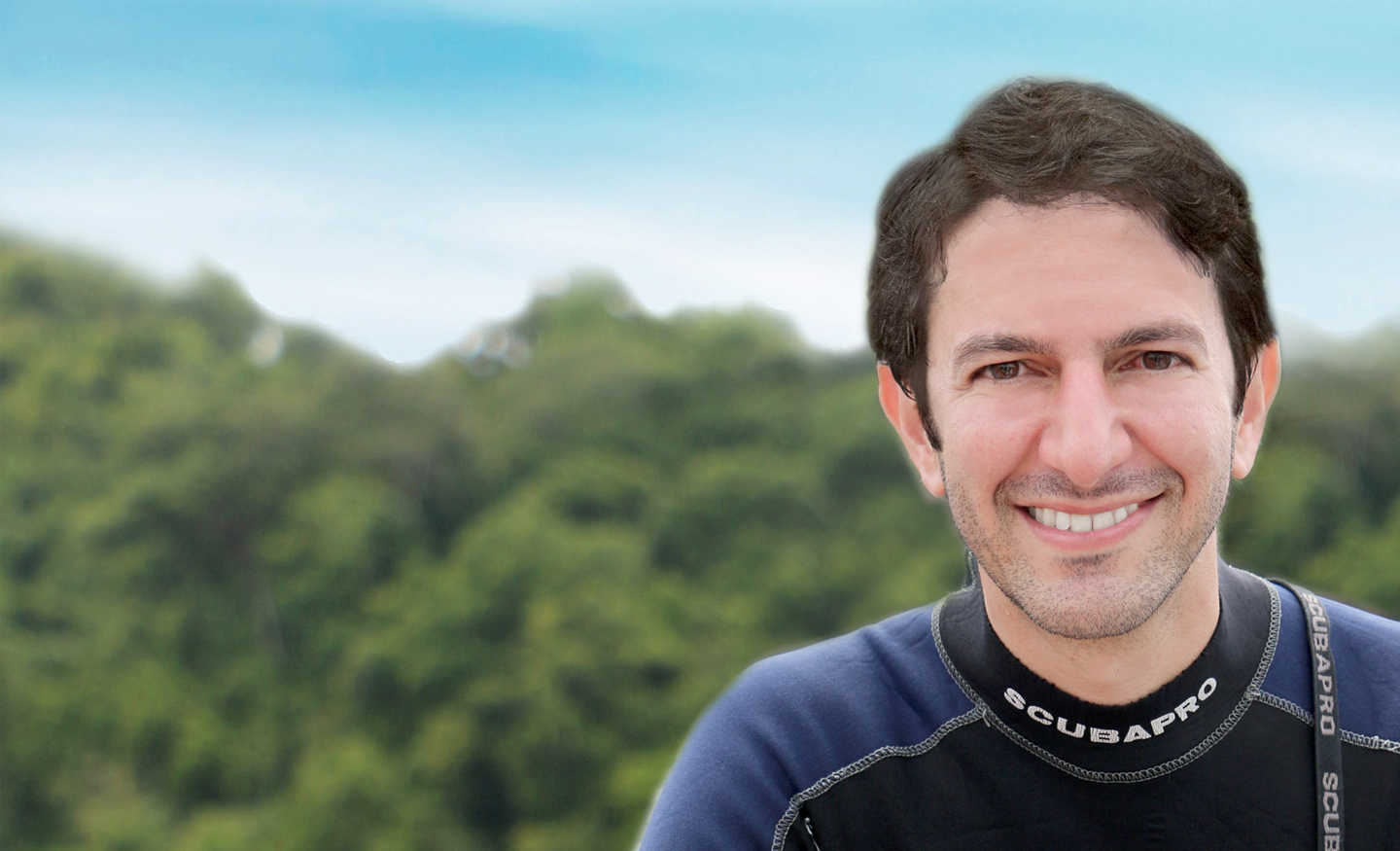

Iván Eskildsen
Ivan is an entrepreneur with experience in the development of projects focusing on Panamanian culture and sustainability. He is also the creator and manager of enterprises that seek to awaken young people interested in Panamanian customs. Ivan specifically focuses on teamwork, inspiring leadership and strengthening community support. Before the age of thirty, Ivan founded and managed the Cubitá Project; a hotel, residential and commercial real estate complex. Its design was inspired by the architecture and traditions of the Azuero region which portrays rich Panamanian history. It is the most important project in the area and has its own private museum. Ivan is the founder and leader of several organizations, chambers and associations of private companies. An avid volunteer, he engages in regional organizations with a focus on sustainable development, community projects and the dedicated practice of practical philosophy and history. Summa Cum Laude, Bentley College, Massachusetts, Bachelor of Finance.

Panama Underscores Commitment Towards Tourism Of The Future
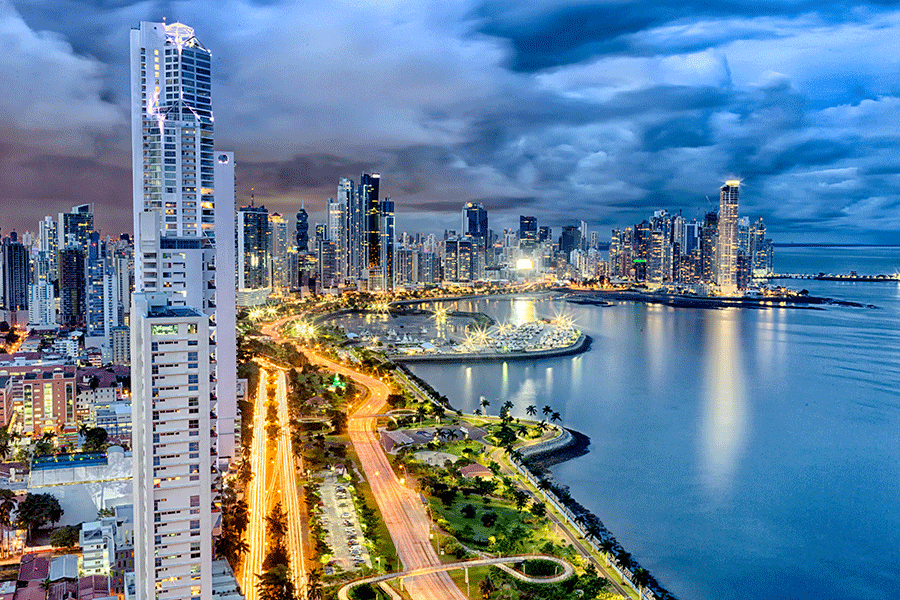
Ivan Eskildsen, Panama’s Minister of Tourism during the signing of the “Transformation Towards the Tourism of the Future” declaration.
PANAMA CITY, PANAMA – MARCH 7, 2022 –Panama, an abundantly rich country in nature, history, and culture, has again underscored its commitment to sustainable tourism by recently signing the new “Transformation Towards the Tourism of the Future” declaration. Attested to by 11 Ministers and high authorities of tourism, the declaration signed in Panama was made in response to the World Tourism Organization’s (UNWTO) call for both governments and the private sector to rethink the purposeful development of the industry as it restarts and recovers from the impacts of the COVID pandemic.

“Our vision of tourism is anchored in sustainability, focusing on contributing to the empowerment of communities, scientific research, the regeneration of ecosystems and local cultures,” says Panama’s Minister of Tourism, Ivan Eskildsen. “Panama is proud to be leading the region with ongoing endeavors to connect travelers to communities, culture, and nature through infrastructure improvement and access to iconic experiences.”
The country’s 2020-2025 Master Plan for Sustainable Tourism, recognized by UNESCO as an example of innovation and sustainability, reactivates Panama’s Tourism, Conservation and Research Strategy (TCI) to highlight the country’s three core heritage pillars. These include Cultural Heritage (multifaceted culture), Green Heritage (extraordinary biodiversity), and Blue Heritage (ocean wonders).
Examples include the work the Tourism Authority of Panama (ATP) is carrying out with local and indigenous communities to reactivate tourism in various areas throughout the country to help preserve and sustain the biocultural legacy of these cultures.
In the Panama Canal watershed, one can travel upstream on the Gatun River to visit the Embera Community, one of the seven indigenous groups that live in Panama. The community welcomes visitors to understand their ancestral culture better and learn their way of life, including art, cosmovision, and rituals. In Bocas del Toro, the government collaborates with coastal Afro-Antillean communities to highlight the region’s unique gastronomy stemming from Caribbean roots and evolved by decades of local influence.
Also underway is a project to develop and rehabilitate 1,000 Km of Trails throughout the country, focusing on integrating the local communities for the benefit they derive from the trails, as well their efforts to help maintain them.
“Panama is brimming with one-of-a kind immersive experiences that invite active travelers to enjoy authentic and colorful pursuits, while making a difference in the country through tourism,” said Fernando Fondevila, PROMTUR Panama’s Chief Executive Officer. “From conserving wildlife and ecosystems, to fostering the growth of local communities, our approach is to appeal to the sensibilities of today’s traveler for immersive engagement and a desire to return.”
In Coiba National Park and its surroundings, the Marine Protection Zone has been expanded through executive orders to protect and enhance marine life, positioning Panama as a global Blue Leader in conservation. The Park allows visitors to learn and experience sustainable living through local communities still practicing artisanal fishing and leading turtle conservation projects. Other regions of interest include the Bay of Panama and the Las Perlas Archipelago , under the observation of the Smithsonian Tropical Research Institute, which offers a haven for migrating whales each year, further enhancing Panama’s reputation for spectacular whale watching.
In the Chiriquí Highlands , where Geisha Coffee – the world’s most valuable coffee – is harvested by the Ngäbe and the Buglé indigenous communities, the government has expanded its coffee circuit to include a range of tourism experiences at local farms. Under development by the ATP and the Center for Competitiveness of the Western Region (CECOMRO), the circuit currently includes 15 coffee farms with goals for 42 farms upon completion.
Other Latam countries joining Panama in signing the Declaration: Transformation Towards the Tourism of the Future include Colombia, Costa Rica, Ecuador, Guatemala, and Honduras. The declaration is also supported and signed by the Adventure Travel Trade Association (ATTA), PROMTUR and the Jordan Tourism Board.
To learn more about Panama’s Cultural, Green and Blue Heritage and visitor experiences, please visit https://visitpanama.com/things-to-do/ .
For Panama’s most updated health and safety protocols, as well as entry requirements, visit www.visitpanama.com/information/travel-guidelines/ .
About Panama Tourism
The Tourism Authority of Panama (ATP) is the Panamanian Government entity that aims to strengthen tourism as a strategic economic sector of Panama, through the Master Plan for Sustainable Tourism (PMTS) 2020-2025. Developing a sustainable model that generates an increase in employment nationwide, integrates communities, articulates the territories and increases the competitiveness of the industry.
Additionally, PROMTUR Panama is the official destination marketing organization (DMO) whose primary purpose is to promote and market Panama internationally. PROMTUR works closely with the ATP to further propel the country’s international promotion as a world-class tourist destination.
Together, ATP and PROMTUR work to promote Panama’s rich history, culture, natural beauty and remote locations, which are experienced through the destination’s three heritage pillars – Cultural Heritage (multifaceted culture), Green Heritage (extraordinary biodiversity) and Blue Heritage (ocean wonders).
For more information, please go to www.visitpanama.com . Follow Panama on Twitter , Facebook and Instagram .
- All Inclusive Resort
- Association and Events
- Host Agency
- Hotel and Resort
- River Cruising
- Tour Operator
- Sales and Marketing
- Your Travel Business
- Suppliers and Destinations
- Trade Associations and Events
- Free Downloads
- Your Travel Agency
- Destination
- Host Agency List
Add Travel Professional NEWS® to your Homescreen!
Panama Is Spending $300 Million With Lofty Goals for Community-Centric Tourism
Lebawit Lily Girma , Skift
October 8th, 2021 at 2:00 AM EDT
The country's new sustainable tourism master plan could set a precedent for the region if the government puts its money where its mouth is. But is Panama's private sector ready to embrace sharing the tourism pie after a major downturn?
Lebawit Lily Girma
Pre-pandemic, Panama was one of the strongest performing economies in the Latin America and Caribbean region, growing at an average of 4.7 percent annually. But that wasn’t the case for its tourism sector, which remained stagnant in comparison to previous years, even with a 16 percent contribution to the gross domestic product.
That outlook was supposed to change in 2020 with the appointment of a new minister of tourism — a millennial entrepreneur with a background in finance and hospitality but no political ties — and the launch of a first-ever destination marketing organization for Panama, PROMTUR . The pandemic slashed visitor numbers in 2020 by over 70 percent as well as hit deeply on other large sectors. But that didn’t stop the country from playing catch up in boosting its economy and transforming its image — through tourism.
Beyond pushing for the return of visitors, the Panamanian government is in the midst of spending an ambitious $301 million for a sustainable tourism master plan. The goal: rebuild Panama’s visitor economy over five years, from 2020-2025, into one that places communities and the environment at the center of tourism’s future growth and benefits.
“We are a country that says we have a canal, and we’ve had a booming real estate industry for years and the financial services sector — tourism, it’s the first time that there’s a master plan and it’s the first time the government, with the cabinet and president, has formally approved a master plan,” said Panama’s minister of tourism, Ivan Eskildsen. “So this is the first time that tourism becomes state policy, and we’re actually moving forward with a sustainable tourism master plan.”
Nature and culture-based tourism as state policy and targeting conscious travelers for it are a central part of this plan. “Now we know there’s an opportunity to attract this demand, to bring in dollars to the country, but at the same time preserving our nature and our culture with involvement of local communities and helping to improve the lives and well being of communities,” Eskildsen told Skift.
As far as sustainability claims go, it sounds basic to declare embracing natural and cultural assets, but Panama’s plan, developed with input from locally established non-governmental organizations as well as international conservation groups, has a regenerative tourism bent. It commits to diversify the industry by officially embracing community-based tourism and making 10 indigenous or Afro-Panamanian communities into tourism destinations, to start.
“What is new about their approach is really trying to map biodiversity assets, community and cultural and historical assets with market and interest from the market, and I think taking a holistic approach to that, and then saying — OK, what are the barriers to entry, how do we help communities, how do we help develop tourism routes and clusters and these kinds of things,” said Jamie Sweeting, president of Planeterra . “Sometimes the market needs a bit of a helping hand.”
If Costa Rica is “Pura Vida,” Panama is now “Vive por mas” or “Live for More” under a new branding platform that launched this month, targeting the conscious traveler and also part of the new tourism master plan.
It’s a radical change ahead for Panama, but it could be planting the seed for a new tourism governance model for a region where the leadership has historically excluded local communities and embraced mass tourism development at the expense of profits. Could Panama be leading the reset that’s desperately needed and make tourism more equitable in the Americas?
Live for More: The Conscious Traveler
Panama’s new branding is relying on the promise of the conscious traveler or the “viajero consciente.”
“So there’s two pieces — there’s on the marketing side we want to attract the right people with the right values, we also on the other side have the tourism authority who has a plan for developing the country in a sustainable way,” said Woodrow Oldford, chief marketing officer at PROMTUR. “So they have to work hand in hand; if we’re building a sustainable country and we don’t brand the country in the appropriate way to attract the right people, we then mess everything up.”
Oldford said that researching the discerning traveler led PROMTUR to find almost 600 million of them that Panama could target. Primary markets include the U.S., Canada, Costa Rica, Colombia, Brazil, Argentina, and in Europe, Spain, Germany and France.
“We found viajeros conscientes in all of those markets,” Oldford said, adding that conscious travelers are also in Australia, as well as Italy, Mexico, Peru, but that efforts were under way to research the latter markets.
PROMTUR has gone has far as segmenting this conscious minded traveler into three tiers: the creative idealist, the history seeker and the holiday globetrotter, all of whom travel to learn and grow, or as a method of self-discovery.
As for the “Live for More” rally cry, Oldford said, it was designed to put Panamanians first.
“So one of the things that we did with the branding instead of doing branding around a visitor only, we put the tourists which is the discerning traveler and the Panamanian at the center of the brand and it had to work for the Panamanian and the visitor at the same time. If it didn’t work for both then it was thrown out.”
Community Empowerment at the Center of Tourism
To push forward the master plan’s commitment to bring to market ten communities and decentralize the industry, Panama’s government formed an alliance at the start of 2021 called the Panamanian Alliance for Community Tourism , alongside the Panamanian Foundation for Sustainable Tourism (APTSO), and non profit organizations Fundación Natura and Planeterra.
“PACTO is a simple and innovative social strategy to demonstrate how community based tourism can train communities to self management, Annie Young, president of the Panamanian Foundation for Sustainable Tourism (APTSO), whose work with communities spans decades.
So far, the foundation’s team have undertaken six months of pre-diagnostics work “pro bono” for the government so far, Young said, in identifying which communities will be part of the national project. Young stressed that communities would be selected based on a transparent scoring system.
“What we did together with Planeterra, we created a matrix with criteria of evaluation; there’s several levels, right, so we evaluated different communities, some communities I visited, my team visits others,” said Young.
One of those questions indicates consent — whether the community is receptive to having tourism in the first place.
“We want to work with communities that want a project because some communities don’t want a project — they say you know what, I work with my fruits, I produce melones and I don’t want tourists bothering me.”
The communities that have the higher scores is the community that will end up in the top 10 as part of the initial push to integrate them into the tourism chain.
The matrix evaluation was completed just days ago but for now the work has paused pending government funds that were promised to push this project forward. as part of the Panama sustainable tourism master plan.
“We are working with our own resources because we have to submit deliverables in order to receive payment,” Young said, adding that APTSO and teams from different partners are having to fork out money for it, to her board of directors’ discontent.
The government of Panama committed to $200,000 to support this portion of Panama’s master sustainable tourism plan and the tourism alliance, but nearly a year in, the funds have yet to be disbursed. That a small NGO is expected to conduct field work of this magnitude pro bono and pre-payment, with an uncertain timeline on disbursement, raises eyebrows and could cast doubt on Panama’s commitment to community tourism.
Tourism minister Eskildsen said this was the norm in government, but that the funds for APTSO were being processed, though unable to provide a specific date.
“We always have an issue in the government with the idea of fast disbursements, but you know we’re managing it and the project has already received the initial approval of our controller’s office, which is the entity that oversees all public funding,” said Eskildsen. “So we’re finalizing the details of the first delivery of the project on behalf of the Foundation, and with that first delivery then we’ll disburse the first payment out of these $200,000, which has a two-year period.”
The goal, Eskildsen added, was to eventually grow past the initial 10 communities that will come through the PACTO alliance.
Changing Tourism Starts At Home
Getting the private sector and all the players in the tourism chain on board informed and getting them to embrace Panama tourism’s new ambition towards a more community-centric and environmentally minded industry will be key in pulling off the plan.
Aside from the Panamanian tourism alliance, efforts are focused on bringing awareness to stakeholders, in various forms — for instance, launching a tour operator contest alongside the United Nations World Tourism Organization with a prize for the tour operator that reinvents its model to accelerate the master plan, inviting U.S. tour operators from the Adventure Trade and Travel Association, and starting a 1,000 kilometer trail improvement project in the country led by a U.S. expert in developing recreation and national parks.
With most of the hotel infrastructure based in Panama City, stimulating investment outside of the city to bring tourists to the rest of the country is also under way, Eskildsen said.
For Planeterra’s Sweeting, bringing on city stakeholders to embrace sustainable tourism and community based activities will be critical given the hub’s importance as a transport hub in the Americas.
“At the end of the day, anybody who’s flying into Panama is flying into Panama City, they’re spending a night or two in the city and they’re going and looking at the canal — so again, most people think of community tourism and they think niche market, it’s off in the rainforest nothing to do with me. But when you start looking at it from the eyes of a traveler coming from Europe or coming from North America to Panama, they’re going to be spending three or four of those nights in a city hotel, because it’s the beginning and the end of the trip. So, how do you get those guys to be supportive of community tourism?”
Mapping it back to what the consumer needs will be key to making Panama’s plan work, Sweeting said, and designing the experiences with those who know their customers. “That’s not just the operators that run trips out of Panama City, it’s also those host hotels that know their guests and know what their guests like to do.”
It’s also about pulling in the locals looking for activities and interested in supporting the communities, not just the expats and the business travelers.
“When I was a tour operator I wanted to work with those communities but one tour operator is not enough, we need the industry to embrace this strategy and the industry to adapt their products to include these communities and include the products of those communities,” said APTSO’s Young. “So that’s what we are doing also working with the private sector.”
A Potential Shift for Tourism in Panama and the Americas
For now, while efforts to push the sustainable tourism plan continue, Panama is targeting regional travelers with its vaccine tourism campaign.
“The vaccination tourism is a window of opportunity where many of our neighbors are not as advanced as Panama; Panama has 73 percent vaccination rate, so as we are well advanced we have neighbors that are 10, 20, 30 percent, we are trying to attract these people towards more traditional tourism experiences such as shopping in Panama City,” Eskildsen said.
Additional tactics to drive demand include a stopover campaign with COPA Airlines and two new charter flights launching from Ecuador and Peru this month.
But Panama’s tourism minister’s said he was focused on transforming Panama’s tourism for the long haul and by extension, building a legacy of a tourism model that places community empowerment at the center and preserves the country’s “bio-cultural heritage” in a world facing a climate crisis and in urgent need of solutions, which necessitates the participation of communities.
“For the first time, which I believe is an element that differentiates this administration, we approached indigenous communities — personally visiting the chiefs of indigenous groups that manage their own territories in Panama,” said Eskildsen. “They’ve been very skeptical in the past and because of all these reasons, as it’s common in the Americas at least, they usually are used and not integrated. They even shared a letter, one of the seven indigenous groups we have, after we shared this draft of our content based on their spiritual traditions, saying they’re very happy that we’re embracing and supporting the preservation of their culture. That never happened in tourism in Panama.”
Will the conscious traveler come flocking to Panama as fast as tourism leaders are anticipating? It’s a trend that younger generations have been helping accelerate, and that destinations previously plagued by mass tourism are monitoring closely. The road is long, but experts remain positive that despite the challenges ahead, change is afoot for Panama’s tourism sector. So long as the funds to make it all happen, match the commitment.
“I feel that this model can be replicated in other regions of Central America, because the tourism of the future is more regional as well post-pandemic,” said APTSO’s Young. “I think it’s coming along, it’s not easy work because there is a lot of criticism when there are companies that are in bankruptcy and people say, these people are talking about birds and Indians. But you know, it is a time to rebuild.”
The Daily Newsletter
Our daily coverage of the global travel industry. Written by editors and analysts from across Skift’s brands.
Have a confidential tip for Skift? Get in touch
Tags: climate change , coronavirus recovery , panama , regenerative tourism , sustainability
Photo credit: Panama's new sustainability plan aims to prioritize community based tourism Marc Veraart / Flickr Commons
- Default Style
- Background 1
- Background 2
- Background 3
- Background 4
- Background 5
- Background 6
- Background 7

Iván Eskildsen: "Panama Fits Right for the MICE Sector"
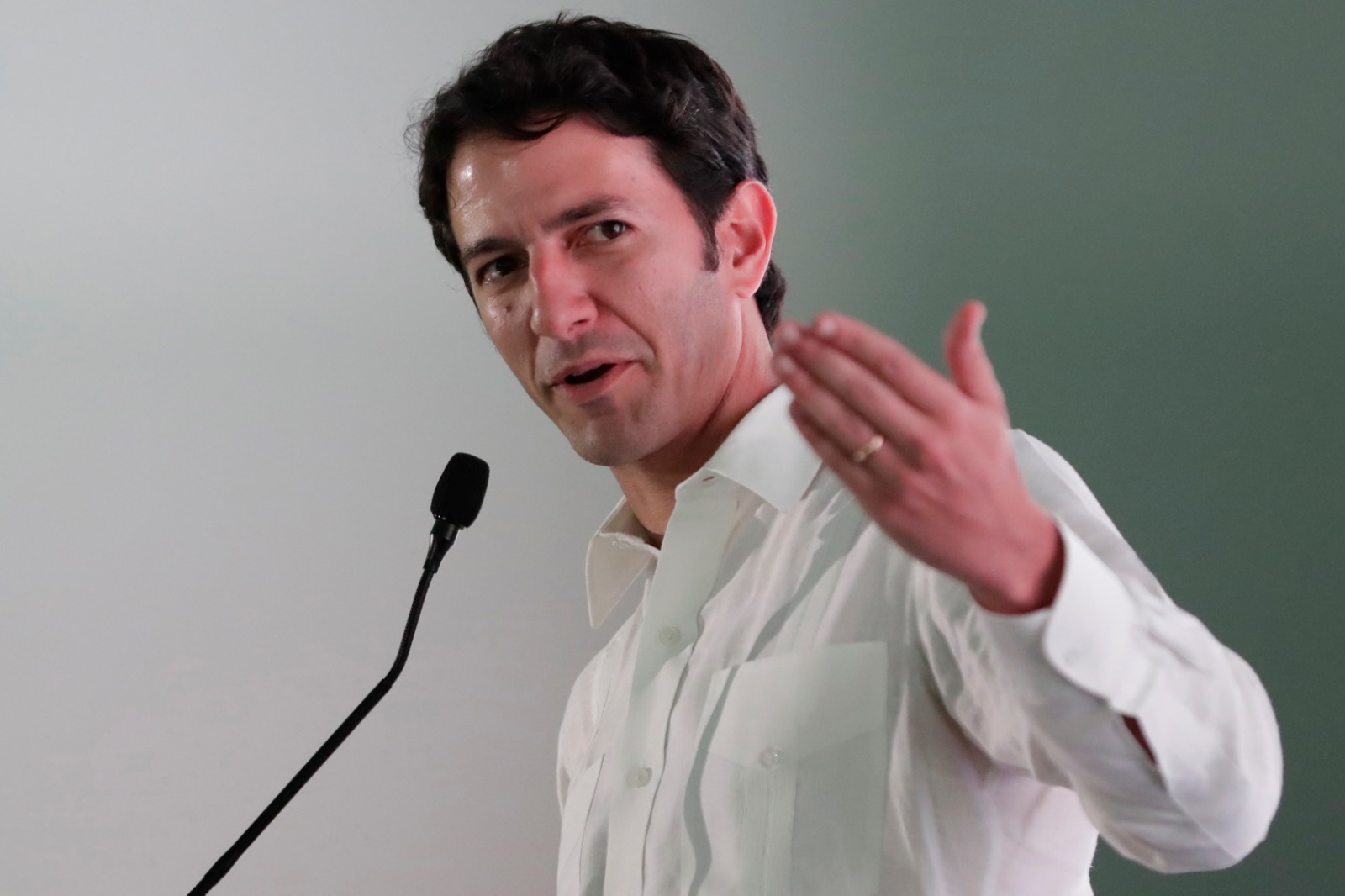
Exclusive interview with Iván Eskildsen, Minister of Tourism of Panama, in the framework of WTM London 2021.
By verónica de santiago.
Panama was the only Central American nation that decided to participate both in person and virtually in the recently concluded edition of WTM London. Caribbean News Digital sat down with Panama's Minister of Tourism, Iván Eskildsen , about the reasons behind this decision, as well as other elements of interest regarding the recovery of the tourism sector in the country.
In this edition of WTM London 2021, Panama has decided to participate in hybrid format (physical and virtual), being the only Central American country that has participated with a physical stand in London. What were the reasons for this decision?
We consider Panama's participation in WTM London 2021 to be timely, as the United Kingdom is a market of opportunity and the event itself is a key meeting point for travel agents and tour operators from all over the world. Being the only Central American country with a physical stand in London gives us a competitive advantage to promote our natural and cultural attractions first hand.
How would you rate the Panama Travel Mart, organized by the National Chamber of Tourism of Panama and held on September 29?
The Panama Travel Mart had very positive results for economic reactivation. According to a report issued by the National Chamber of Tourism of Panama (CAMTUR), Panama Travel Mart, which was held within the framework of the fifth National Tourism Convention (CONATUR), at the beginning of last October, left an estimated US$30 million in business, with different suppliers including more than eight charter operations, already confirmed from Colombia, with more than 1,200 passengers with a projection in 2022 of 4,000 passengers.
In its first edition, the Panama Travel Mart had 430 scheduled appointments between buyers and sellers of tourism products, which were 100% fulfilled during the two-day round of negotiations.
Panama plans to hold four other fairs, approved by the National Government as part of the economic reactivation: Flowers and Coffee Fair; La Chorrera International Fair; San José de David International Fair, and the Azuero International Fair. What is the scope of these fairs and how much can they contribute to the recovery of the tourism sector?
An estimated impact of B/. 154,785,000 that will boost the economy of these regions. The first four activities approved, for the moment, as part of the economic reactivation are: Flower and Coffee Fair, in Boquete, from January 13 to 23; La Chorrera International Fair, from January 26 to February 6; San José de David International Fair, from March 10 to 20; and the Azuero International Fair, from April 21 to May 1.
These activities seek to support merchants, projecting economic benefits in the order of B/. 154,785,000, in these regions of the country.
Can we say that Panama is relying heavily on the MICE sector to boost the recovery of tourism?
It is an important line within the industry to reactivate the economy, a convention tourist has an average daily expenditure of $609 vs. the leisure tourist who spends $350.
Panama is the ideal destination for the MICE product because of its maritime and air connectivity, climate stability, the capital offers a varied hotel stock of 20,000 rooms; you can choose whether to stay among skyscrapers or surrounded by nature, in the middle of the city.
In fact, our recently inaugurated Panama Convention Center is located on the banks of the Panama Canal, surrounded by a biodiverse and exuberant tropical nature; it is a modern structure, equipped with state-of-the-art technology, with a capacity for 25 thousand people.
Can you give us an update on the health security protocols in force in Panama for the entry of international tourism?
To enter Panama visitors must have their complete vaccination schedule and use masks, there are countries still considered high risk, in that case the person must comply with a quarantine of 3 days and take a swab at your expense, unless they are only in connection.
Currently we offer AstraZeneca vaccines for tourists totally free of charge, the only requirements are: to be over 18 years of age and to have a minimum stay of 2 nights in a hotel duly registered with the Panama Tourism Authority.
What is Panama City doing to recover from the impact of the pandemic?
This year 2021, both in Panama City and in the rest of the country, a gradual reopening was carried out as the vaccination process and the decrease in the number of infections progressed.
We have 70% of the population vaccinated, almost 6 million doses applied, the third dose has started to be given to risk groups and a shipment has already arrived and we are currently negotiating the purchase of 1.5 million pediatric doses of the vaccine against covid-19 to immunize children between 5 and 11 years of age, which we expect to start applying in the first quarter of 2022.
You Might Also Like This

- BECOME A MEMBER

Iván Eskildsen, Minister of Tourism of Panama / General Administrator of the Panama Tourism Authority

Visit Latin America: What is the current situation of tourism in Panama?
Since Panama opened its borders to passengers, thanks to the success of the vaccination programme implemented by the health authorities, the country has begun to recover its economy.
This has resulted in the arrival of major airlines such as Air Europa, which recently resumed flights to the Panamanian isthmus with its best Boeing fleet, but also charter flights from Canada with Air Transat and Sunwing airlines, both of which had 12 flights scheduled in December; the arrival of cruise ships in the country’s main ports and in particular in the new Panama cruise port, which has the capacity to accommodate two ships of more than 4,500 passengers each; the holding of international events in the recently inaugurated Panama Convention Centre, with more than 17 events planned for 2022.
VLA: What targets have you set in terms of visitors for the next 3 years?
From 2022 onwards, the Sustainable Tourism Master Plan foresees a realistic scenario of 2.3 million tourists coming to Panama annually.
VLA: Can you summarise in a few lines what the SUSTAINABLE TOURISM MASTER PLAN consists of?
The plan aims for Panama to be recognised as a world-class sustainable tourism destination, for its extraordinary wealth and diversity, its natural and cultural heritage, and for the quality of its services. This document, with which Panama has succeeded in reimagining its sustainable and conscious tourism, is closely linked to the Colmena Plan, one of President Laurentino Cortizo’s flagship projects, which aims to improve the quality of life of our country’s poorest communities.
VLA: How does responsible and sustainable tourism manifest itself in the MAESTRO PLAN?
After 13 years of developing the last Sustainable Tourism Master Plan (2007 – 2020), Panama is reimagining its tourism model with the update and implementation of the Sustainable Tourism Master Plan (2020 – 2025), a roadmap for the decentralised development of the tourism industry and in which the country’s differentiated offer is highlighted.
The document contributes to the creation of jobs, the fight against poverty and inequality, implementing the TCI (Tourism-Conservation-Research) economic model, which after more than 20 years has been reactivated and incorporated in this plan update, with the new vision for 2025: “To be recognised as a world-class sustainable tourism destination, thanks to the extraordinary richness and diversity of its natural and cultural heritage, and the quality of its services”.
According to the CCI’s approach, the quality of a destination’s natural and cultural attractions defines its competitive strength, in large part because they are very difficult to replicate. And each element of heritage (cultural or natural), is meaningful both for its intrinsic elements, and for the history of those who have participated in the maintenance of that landscape or in the making of the object observed: it is proposed to have a scientific explanation of the resource in order to make the most of it.
Hence the importance of focusing efforts on the conservation of these resources and on research projects to keep them attractive. All this happens, moreover, in a context where the consumer (SUN PLUS, according to the terminology of the model) is looking for just that: experiences beyond the sun/beach or basic visits. The term “more” refers to the additional quality that consumers demand (since 1999) from cultural and natural resources to justify their trips. It is therefore essential that the interaction between the three areas of the model is well articulated and provides mutual benefits in a sustainable way over time:
– Tourists who have a positive experience of their visit to attractions (natural, cultural, historical, etc.) will generate a positive economic impact for the destination, including for the managers of these resources and the researchers;
– Researchers contribute their findings, which ensures that the destination remains attractive, with more memorable features;
– Conservation managers benefit from increased funding and a better image for their projects, which ensures better safeguarding of resources.
In line with the sustainable tourism trends of our time, the plan helps to improve the correlation between tourism-led economic development and community and environmental well-being. The different elements that make up the Panamanian offer, from the landscape to the natural and human resources, have a new and greater coherence if they are integrated into the concept of a heritage route, emphasizing the most remarkable characteristic of the Panamanian territory and society: its capacity to function as a route since time immemorial.
Thus, each site of heritage interest, building or landscape included in a route should be at the centre of a commercial tourism activity, a site conservation activity (with the participation of the local population, who would thus benefit from the commercial activity) and a research activity (which tourism revenues could finance in whole or in part) in order to better understand the resource.
VLA: What are the main achievements you have already made?
“Live for more: a new tourism brand platform that will be maintained consistently over time.
This year we have reached a fundamental step for a consistent positioning in the target markets (United States, Canada, Colombia, Brazil, Costa Rica, Argentina, France, Germany and Spain), the launch of the new Panama tourism brand platform, anchored on the concept “Live for more” that connects Panama and its tourism offer to the conscious traveller, a market of 500 million travellers interested in authentic destinations and in leaving a positive impact in the countries they visit.
With this launch, we begin an unprecedented process for the tourism industry in Panama, with a marketing platform that will remain over time and allow us to promote Panama internationally in a continuous and consistent manner. All this is based on the ATP Sustainable Tourism Master Plan, our roadmap.
Since its official launch on 29 September, “Vive por más” has reached over 17.7 million users on the YouTube platform.
We maintain Panama’s 24/7 presence in our target markets through digital campaigns and international marketing and PR actions that keep it relevant. Thanks to this strategy, we have managed to appear in important international media such as Condé Nast Traveler and Travel+Leisure.
Panama has also positioned itself as a leading destination in the region for congresses, conventions and incentive travel (MICE), thanks to its connectivity, accessibility, hotel facilities, meeting spaces and diversity of tourist attractions for groups.
We have contributed to Panama’s positioning in this important tourism segment through the Incentive Plan, where we have managed to attract 25 international events and we maintain more than 60 active requests for events between 2022 and 2027.
We can also announce that Panama will host FIEXPO Latin America 2022, 2023 and 2024, the most important meeting tourism show in the region.
VLA: What message would you like to send to the tourism industry?
In the midst of an unprecedented global crisis, which has hit the tourism industry hard, forcing it to distance itself and restrict free passage, we have taken advantage of the situation to analyse ourselves in depth and reorganise. As we did together, the private and public sector, we were able to overcome the worst of this crisis in unity. Now that the restrictions have been lifted, we face a huge challenge: to reposition ourselves as an industry, as a brand and as a unique destination. We have no doubt that we will achieve these goals, and we are already seeing the results.
RECENT POSTS

“The Sofitel Legend Casco Viejo combines French elegance with the charm of Panamanian culture”
Oct 10, 2022
Interviews David Kianni, General Manager of the Sofitel Legend Casco Viejo in Panama Visit Latin America: Can you introduce us to the Sofitel Legend Casco Viejo? Sofitel Legend Casco Viejo, Panama is a historic place which blends French elegance with the...

“ The year 2022 has definitely arrived with a wind of hope”
Aug 9, 2022
Interviews Carolina Briones, Secretary General of the Central American Tourism Promotion Agency (CATA) Visit Latin America: CATA received the 2021 International Tourism Excellence Award for its actions during the pandemic. How is 2022 going in terms of tourist numbers...
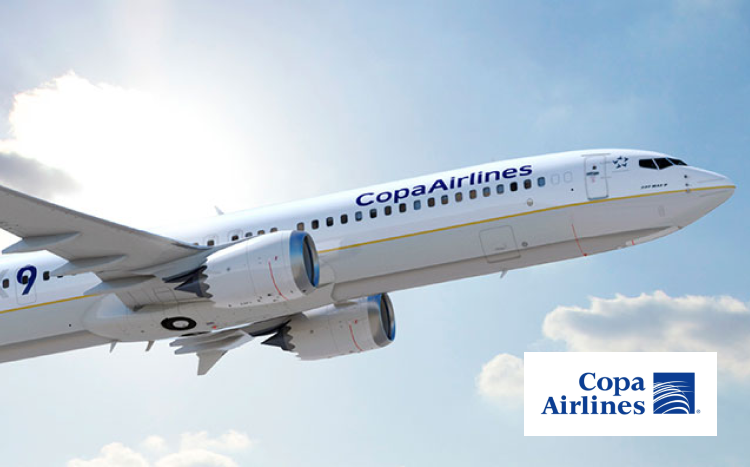

“Our goal is very clear: to be the hub of the Americas”
May 27, 2022
Interviews Christophe Didier, Sales Vice President of Copa Airlines Visit Latin America: COPA Airlines is 75 years old this year, what has been the key to its success and longevity? We have a very clear vision and objectives to be the leading airline and preferred...
You may also like:
Share this article:, submit a comment.
You must be logged in to post a comment.
We use cookies
Caf and panama tourism authority build ties to promote sustainable tourism.
March 16, 2023
The signing of the document is yet another step in the roadmap to reinforce the strategic partnership between the multilateral bank and the Central American nation and an optimistic bid on the recovery of local tourism indicators, in an effort to converge towards levels seen before the Covid-19 pandemic.

CAF—development bank of Latin America—and Panama’s Tourism Authority (ATP) signed a Memorandum of Understanding to advance sustainable tourism, as yet another milestone in the context of the 25th anniversary of Panama’s accession as a full member of CAF.
The instrument was signed by Tourism Minister Iván Eskildsen and CAF representative in Panama Lucía Meza, with CAF Executive President Sergio Díaz-Granados acting as a witness of honor.
Eskildsen thanked CAF and reported on plans for the expansion of the Sustainable Tourism Master Plan (PMTS), projected until 2030. He assured the PMTS is a State pledge, and therefore, at the ATP, “we are arranging possible conversations with the different presidential candidates in order to ensure continuity of the plan.”
Meanwhile, CAF representative in Panama Lucía Meza explained that “Panama has taken firm steps in advancing tourism as a State policy, through the proposal of a Sustainable Tourism Master Plan (PMTS), reinforced by a continued aggressive investment in infrastructure and logistics, which ensures readily accessible local connectivity, a regional and international spillover effect that leads to economic recovery in areas that foster sustainability; therefore, CAF values and supports this country vision.”
Lastly, CAF Executive President Sergio Díaz-Granados underscored Panama’s positioning as a tourist destination and took the chance to present to the minister the construction project for CAF’s North Hub in the Obarrio area, which he referred to as “a dream to contribute to cultural tourism in Panama City.”
Our cooperation agreement with ATP aims to advance sustainable tourism as a key to improving living conditions in tourist destinations, creating economic opportunities, jobs, and serving as a catalyst to enhance cultural heritage and the environment, as well as reinforcing regional integration and cooperation through tourism.
The parties agreed to explore the possibility of fostering and developing joint projects and actions to bolster the PMTS with technical assistance and funding, in the context of CAF’s action for sustainable development, the impact of the sector on economic recovery with action in the green and blue economy, including joint work with non-governmental entities, the private sector and other international organizations.
The agreement also opens the door to supporting implementation of land use plans, road, port and dock infrastructure projects, and basic clean water and sanitation services in the regions, solid waste management, mapping, and enhancement of green and blue trails, initiatives for beach cleaning and maintenance, ventures for small and medium-sized enterprises, and the chain of tourist services.
Latest news:
Paving and maintenance of rural roads to guarantee progress in peru.
June 25, 2024
CAF and MCDF support Jamaica’s vision for a global logistics hub
June 24, 2024
What's next for the Regional Brand? 5 Lessons from Chile
June 17, 2024

Transformation Towards Tourism of the Future – Declaration Signed in Panama
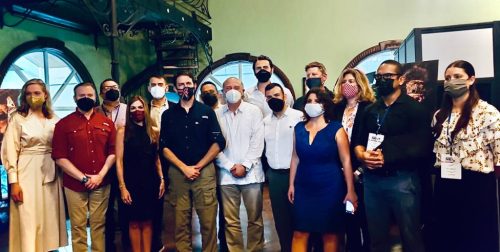
While the host country Panama welcomes buyers from eight countries to the ATTA event, Latin American Adventure Next held in Panama City, Iván Eskildsen, Minister of Tourism of Panama extended the invitations to the regional ministers to discuss tourism sector collaboration. Eskildsen’s team initiated the declaration idea and prepared the draft. Following a two-hour, round-table discussion, the ministers all agreed to support the Declaration, which received 11 signatures.
The support was given by the ministers of tourism of Panama (Iván Eskildsen), Colombia (Ricardo Galindo), Costa Rica (Gustavo Alvarado), Ecuador (Niels Olsen), Guatemala (Alejandro De León) and Honduras (Luis Guillermo Chévez), joined by the high authorities of Brazil (Bruno Wending, Secretary of Tourism, Mato Grosso do Sul), Panama (Fernando Fondevila, Executive Director, PROMTUR) and Jordan (Malia Asfour, Director of North America), as well as Shannon Stowell, ATTA CEO, and Gabi Stowell, ATTA Regional Director for Latin America & Caribbean.
The Declaration is in response to a call by UNWTO for the public and private sectors to reconsider the development of the industry as it recovers. UNWTO has identified this time as an opportunity to accelerate tourism’s shift towards greater sustainability.
When asked what prompted him to lead this regional collaborative initiative, Eskildsen says, “As human beings, we need to improve the way we do things in relation to the planet, to people and to our countries. Latin America has amazing similarities such as biodiversity and cultures. We are with the type of mindset: If we can share experiences to improve our wellbeing in our region, then it’s also good for the individual countries. What is good for the beehive, would benefit individual bees, like Marcus Aurelius of Roma said. Our Declaration draft received support from all ministers, who are also supporters of better ideas and more visionary strategies.”
Eskildsen states that Panama will continue to implement its blueprint, the Sustainable Tourism Master Plan approved by the Cabinet and the President. Among many strategies, Panama will continue to work on innovative tourism experiences with the private sector, to showcase and to get the interests of the international markets.

Haybina is an international travel industry reporter and has been reporting in both Chinese and English. Linkedin
DECLARATION: TRANSFORMATION TOWARDS THE TOURISM OF THE FUTURE
that the future of tourism is collaborative, bringing together the ancestral wisdom of local and indigenous communities with pioneering scientific and economic knowledge in service to long-term stewardship of integrated ecosystems.
the future of tourism is regenerative. It is our opportunity to rethink the way we interact with nature and people to regenerate invaluable ancestral knowledge in order to face the current anthropogenic climate crisis.
WE RECOGNIZE
the future of tourism is green and blue. It is imperative that our industry protect and regenerate the last wild places and carbon sinks in both land and ocean.
WE ARE COMMITTED
to the transformation towards a carbon-neutral and more socially resilient tourism economy – including new business models through digitalization – thus providing the opportunity to ensure a fair distribution of its benefits and contributing to a global economic reactivation.
Signed in Panama City, the 9th of February, 2022.
Four Seasons Hotels with Experiential Tented Resort in Punta Mita
UNWTO Making Communities Central Part of Tourism’s Future
Welcome, Login to your account.
Recover your password.
A password will be e-mailed to you.

The Panama Tourism Authority is the government organization that encompasses, encourages, promotes and regulates all touristic related activities in the Republic of Panama.
In recent years, we have experienced tremendous growth in the flow of visitors, making the country one of the main leaders of the region as a result of a wide range of services, modern infrastructure, tourist attractions. specialized logistics and excellent air connectivity that can reach anywhere in the world, with an air rate of more than 1, 500 weekly flights departing north and south America and Europe. Tocumen International Airport is considered the “Hub of the Americas”.
The strategic objectives of this entity are:
- Turn Panama into a center of first order in terms of providing services in the business world.
- Use Tourism as a key tool to promote Panama as an ideal country to visit, to live and to do business.
- Encourage the image of Panama at the International level in order to create an adequate identity for global tourism investment.
- Turning tourism into a key instrument for generating jobs and increasing exports.
- Establish international missions dedicated for the promotion of tourism investment and the creation supporting infrastructures.
- Create an enabling environment to receive foreign investments supported by the local private company.
- Create the right conditions to provide tourists who visit Panama with a world-class service.
- Use tourism as the ideal instrument to achieve economies of scale.
Expand the hotel capacity, develop activities and attractive tourist products, in order to ensure and improve receptive tourism services.
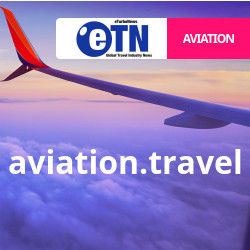
Ivan Eskildsen: Republic of Panama’s New Minister of Tourism
Ivan Eskildsen: Republic of Panama’s New Minister of Tourism –
Who He Is YES, he is young, and attractive and NO, he has no prior experience in government or politics, and – just like that – Ivan Eskildsen became the new Minister of Tourism from Panama. This Panamanian entrepreneur graduated Summa Cum Laude from Bentley College with a BS degree in Finance. Before the age of 30 he developed the Cubit Project, a hotel, residential and commercial real estate complex that was inspired by the architecture and tradition of the […]
Click here to read: eTurboNews | TravelIndustry News http://dlvr.it/SQdQkC
Share this:
- Click to share on Twitter (Opens in new window)
- Click to share on Facebook (Opens in new window)
- Click to share on LinkedIn (Opens in new window)
- Click to print (Opens in new window)
- Click to email a link to a friend (Opens in new window)


News & Updates
Leave no trace develops training strategy with panamá ministry of tourism.

PANAMÁ CITY, PANAMÁ — Parque Natural Metropolitano sits on a hill north of downtown Panamá City. This 230-hectare park protects vast expanses of tropical semi-deciduous forest within the city limits, and serves as an incredible wilderness escape from the busy capital.
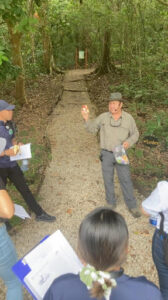
In January, 12 staff members representing parks and tourism professionals from across Panamá, met with Leave No Trace to discuss Panamá’s vision for responsible visitation and its recreation future. With the help of in-person translators, Leave No Trace Education Department leaders JD Tanner and Andrew Leary taught the Master Educator course in Spanish.
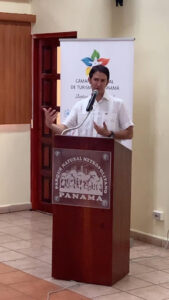
The commitment to Leave No Trace education goes beyond Parque Natural Metropolitano . Decision makers at the highest levels of Panama’s government have taken note of the new educational initiative. “We are committed to developing our adventure travel industry with a strong visitor ethics component, so training instructors with Leave No Trace ’s principles are a very relevant step for us in that direction,” said Iván Eskildsen, Panama’s Minister of Tourism, in a recent Linked post reflecting on the Leave No Trace course made possible by his office, Autoridad de Turismo Panamá (the Ministry of Tourism).
Panamá is embarking on a visitor economy strategy that leverages its parks, natural areas and emerging network of cross-country trails. This is a familiar story to many destination professionals in the United States who for years have leveraged parks and protected areas to attract visitors. For decades, tourism professionals in the U.S. used to invite people to experience the beauty and grandeur of National Parks and protected Wilderness-areas while leaving the conservation education duties to resource-strapped land managers.
But now—in part fueled by the effects of the COVID-19 pandemic and people’s desires to spend time outdoors—destination professionals are deploying strategies to reach visitors with responsible recreation education based on Leave No Trace during the trip planning phase.
“We made a breakthrough with these education strategies when tourism organizations at state and county levels began to incorporate effective Leave No Trace education into their marketing efforts,” says Andrew Leary, Director of Sustainable Tourism and Partnerships at Leave No Trace. “What we’ve seen as a result is improved natural resource conditions in parks, more informed visitors, and improved relationships between tourism and community stakeholders that has traditionally been a source of friction.”
Where Panamá differs compared to the U.S. approach, however, is where the most opportunity lies: building Leave No Trace education into a tourism-driven recreation visitor economy from the ground-up.
“Having Leave No Trace in Panama helps us create an outdoor ethic in this country,” says Adrian Benedetti, coordinator of the 1,000 Kilometer Trails Project. “ Now that the Panamanian government is investing through the trails project and considering this sector strategically, we can also accompany the promoting of outdoor recreation and visitation to parks and protected areas with introducing and education and ethics program that can help guides; that can help places that have environmental education programs; that can help government institutions that are engaged in this issue to see clearly how we can promote visitation in a more sustainable manner and help prepare visitors for safer and more sustainable experiences.”
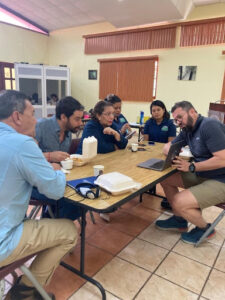
“Leading a Spanish-language Leave No Trace course provided an amazing chance to examine responsible visitation and Leave No Trace through the Panamanian culture, where the idea of “wilderness” does not have a direct translation,” said Leary. “Throughout the entire week, my colleagues at Autoridad de Turismo Panamá (the Ministry of Tourism), Ministerio de Ambiente (the Ministry of the Environment), Fundacion AviFauna (Panama Rainforest Discovery Center), Parque Natural Metropolitano and Parque Municipal Summit showed great care and forward thinking for how the Leave No Trace may provide five new approaches to implement a country-wide education platform that begins with Panamanians, the visitor economy and then visitors themselves,” says Leary.
Where Panama takes its new strategies will certainly be shaped by the upcoming government elections in May. For the time being, however, 12 newly certified Leave No Trace Master Educators and their supporters at the ministry level will offer as many as 24 Leave No Trace education courses to fellow Panamanians over the next 12 months. Benedetti also sees a Panama Leave No Trace alliance on the horizon. “Why reinvent the wheel when we have these Seven Principles that are fairly universal to the outdoor recreation experience? There may be some nuances — that’s what we’ll get into developing so that we can support the Panamanian version of the outdoor recreation experience.”
Let’s protect and enjoy our natural world together
Get the latest in Leave No Trace eNews in your inbox so you can stay informed and involved.
- First Name *
- Last Name *
- Email Address *
- State Alabama Alaska Arizona Arkansas California Colorado Connecticut Delaware District of Columbia Florida Georgia Hawaii Idaho Illinois Indiana Iowa Kansas Kentucky Louisiana Maine Maryland Massachusetts Michigan Minnesota Mississippi Missouri Montana Nebraska Nevada New Hampshire New Jersey New Mexico New York North Carolina North Dakota Ohio Oklahoma Oregon Pennsylvania Rhode Island South Carolina South Dakota Tennessee Texas Utah Vermont Virginia Washington West Virginia Wisconsin Wyoming Armed Forces Americas Armed Forces Europe Armed Forces Pacific
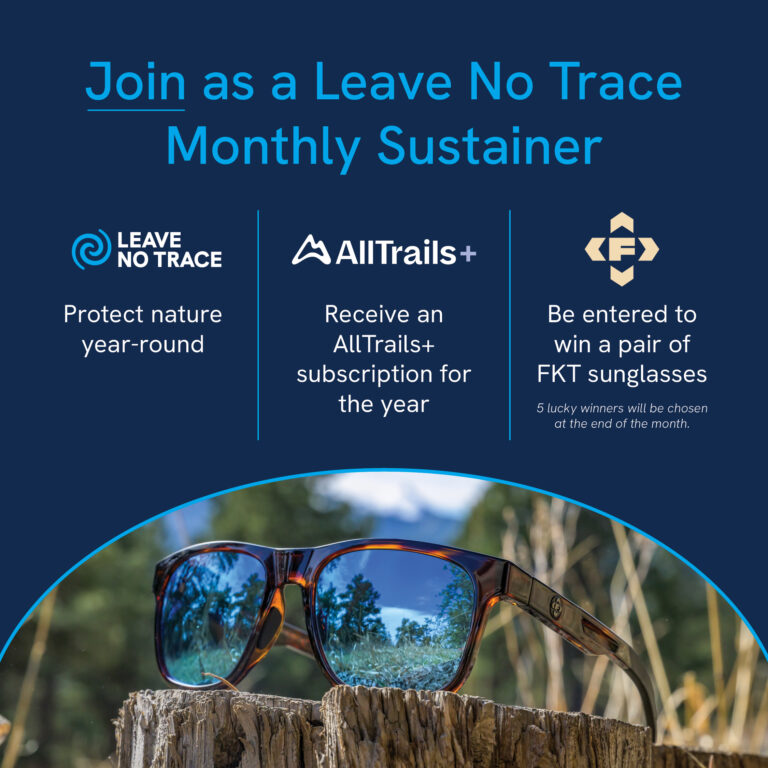
Join, renew or donate through Monday, July 6th, for a chance to win the Big Agnes, REI & Yeti deluxe summer prize package!
- Search Please fill out this field.
- Manage Your Subscription
- Give a Gift Subscription
- Newsletters
- Sweepstakes
Panama Is Reopening for International Visitors in October
"Our beautiful country, rich in nature, biodiversity, and cultural heritage is once again ready to be discovered," Panama's Minister of Tourism said.
:max_bytes(150000):strip_icc():format(webp)/cailey-rizzo-author-page-pic-7f06c5208014435080678b3158fc7861.jpeg)
Panama announced it will reopen its borders to international visitors on Oct. 12, with several new COVID-19 precautions in place.
Travelers to Panama must present negative COVID-19 test results, taken within 48 hours of arrival. Those whose results are older than 48 hours will be required to take a rapid COVID-19 test at the airport, at a cost of about $30. There are no arrival restrictions based on country, anyone can enter Panama.
“After closing our borders to travelers in late March, we are excited to safely welcome visitors back to Panama,” Panama's Minister of Tourism, Ivan Eskildsen, said in a statement shared with Travel + Leisure. “The new health and safety protocols reflect our continuous hard work and dedication in protecting both Panamanians and our visitors, and through our efforts, have earned the World Travel & Tourism Council (WTTC) Safe Travels stamp of approval. Our beautiful country, rich in nature, biodiversity, and cultural heritage is once again ready to be discovered.”
Before checking in for a flight, passengers must also complete an electronic affidavit, agreeing to comply with the Ministry of Health’s COVID-19 measures in Panama . If a traveler is deemed to have contracted COVID-19 upon arrival, they will have to quarantine for seven days at a hotel, paid for by the Panamanian government. They will be tested again at the end of the quarantine period.
Face masks are required in all public spaces and electronic payments at shops and restaurants are preferred to reduce person-to-person contact. Visitors should also obey social distancing measures and follow directions on signs when posted.
Anyone looking to dine in a restaurant should consider making reservations in advance as seating is limited as restaurants have to abide by social distancing between tables. Tours are also operating with limited capacity, down to 50% in ground transportation vehicles.
While travel health insurance isn’t required for entry into Panama, it is highly recommended.
Earlier this month, Colombia reopened its borders to international flights and several Caribbean islands have been doing the same.
Cailey Rizzo is a contributing writer for Travel + Leisure, currently based in Brooklyn. When in a new city, she's usually out to discover under-the-radar art, culture, and secondhand stores. No matter her location, you can find her on Twitter , on Instagram or at caileyrizzo.com.
Related Articles
Your browser is not supported for this experience. We recommend using Chrome, Firefox, Edge, or Safari.

A land radiating with life, perfectly imperfect, and full of authenticity. Where Northern and Southern worlds connect, old and new worlds coexist, and cosmopolitan landscapes live in harmony with wild, untamed rainforests.
A country for those who seek beyond expectations, that dares you to see more. Taste more. Connect more. Feel more. A place for those who long more stimulation, connection and transformation. Panamá is not the destination, but the journey to discover more of what truly matters.
Make more lasting memories through an explosion of inspiration and purpose. And let the spirit of Panamá unlock a sense of belonging.
Panamá. Live for More.
Panamá's unique location provides the experience of a lifetime. We are gifted with having a wide range of rainforests, a desert, and breathtaking beaches on both coastlines, the Caribbean and the Pacific, all within driving distance of a cosmopolitan city. Ready to start exploring?
March to October
Best swell for surfing, june 3rd to 18th, corpus christi festival, june to november, best time for river rafting, march to august, tuna fishing season, birdwatching, hiking & waterfalls, visit indigenous communities, places to visit, panama city.
Panama City is much more than the country's capital. Here you can pedal in front of a skyline with some of the tallest skyscrapers in Latin America, enjoy the Pacific breeze as you ride along the Bay of Panama, walk among archaeological sites and trails, and see how colonial history and the night come alive in the same place. Panama City is a high-contrast destination where greenery, indigenous peoples and vibrant city life are waiting for you.
Bocas Del Toro
Bocas del Toro is one of the favorite destinations among Panamanians and visitors. Just a 45-minute flight from Panama City brings you to the north-westernmost province of the country. Immerse yourself in its cultures, cross forest-covered mountains, sail through mangroves, swim among reefs, surf the perfect wave and discover the good vibes of Bocas.
Boquete is a colorful, wooded valley surrounded by the mountains of Chiriquí, in northwestern Panamá. The valley of dreams? Maybe so. This is a recurring destination for those who dream of trails with waterfalls and exotic animals, climbing natural rock formations, tasting the best coffee and enjoying excellent seasonal meals. Discover this unique place where peace and adrenaline converge.
Tierras Altas
The Tierras Altas region is a quite different place from the rest of Panamá. It is a mountainous district located in the extreme west of the country, in the province of Chiriquí. Take in its peaks, forests, rivers, and set out on an adventure among agriculture and culinary activities it has in store for you. Can you fathom how it feels to see both oceans at the same time? Well, in Tierras Altas, you can!
Riviera Pacifica
The Riviera Pacifica extends along the Pan-American Highway, a 25 mile (40 km) stretch of road dotted with beaches and mountains. On your way out of Panama City, just 50 miles (80 km), on your left, you’ll see a number of beaches where you can enjoy the best plans in the Pacific. And on your right, mountainous areas await that are brimming with trails, waterfalls and adventures in a cooler climate. Which one sounds best to you?
Pedasí & Tonosí
The province of Los Santos, located in the south of Panamá, is the cradle of folklore. At the end, towards the Pacific, there are two unique points: Pedasi and Tonosi. Here you will enjoy natural beauties such as the migration of humpback whales from July to October. You can also visit Isla Iguana to dive over the oldest and largest coral reef in the Gulf of Panama and see many of the birds and iguanas that live there.
Pacific Coast of Veraguas
The province of Veraguas in central Panamá is an exciting destination full of epic adventures. Its Pacific coast is a true jewel where lovers of the sea and wildlife coexist to enjoy the beauties of the region.
In the province of Colón, facing the Caribbean Sea, you'll find Portobelo. Legend has it that Columbus named Portobelo as soon as he saw it. The color of its deep blue sea, the white of its beaches, along with the intense green of its forests and mangroves, deserve no other name: it is a beautiful port. Come and discover it for yourself!
We’re sorry, this site is currently experiencing technical difficulties. Please try again in a few moments. Exception: request blocked

IMAGES
COMMENTS
Who He Is. YES, he is young, and attractive and NO, he has no prior experience in government or politics, and - just like that - Ivan Eskildsen became the new Minister of Tourism from Panama ...
Tweets by ATP_panama Visión 2020 - 2025 "Ser reconocido como un destino turístico sostenible de clase mundial, gracias a la extraordinaria riqueza y diversidad de su patrimonio natural y cultural, y a la calidad de sus servicios."
Ivan Eskildsen, the minister of tourism for Panama, has expressed his delight in the pent-up demand in the U.K. to visit Panama, which was recently removed from U.K.'s red list of countries ...
Iván Eskildsen. Minister of Tourism. Government of Panama. v. Ivan is an entrepreneur with experience in the development of projects focusing on Panamanian culture and sustainability. He is also the creator and manager of enterprises that seek to awaken young people interested in Panamanian customs. Ivan specifically focuses on teamwork ...
PANAMA CITY, PANAMA - MARCH 7, 2022 -Panama, an abundantly rich country in nature, history, and culture, has again underscored its commitment to sustainable tourism by recently signing the new "Transformation Towards the Tourism of the Future" declaration. Attested to by 11 Ministers and high authorities of tourism, the declaration signed in Panama was made in response to the World ...
Beyond pushing for the return of visitors, the Panamanian government is in the midst of spending an ambitious $301 million for a sustainable tourism master plan. The goal: rebuild Panama's ...
Exclusive interview with Iván Eskildsen, Minister of Tourism of Panama, in the framework of WTM London 2021. By Verónica de Santiago Panama was the only Central American nation that decided to participate both in person and virtually in the recently concluded edition of WTM London. Caribbean News Digital sat down with Panama's Minister of Tourism, Iván Eskildsen, about the reasons behind ...
After 13 years of developing the last Sustainable Tourism Master Plan (2007 - 2020), Panama is reimagining its tourism model with the update and implementation of the Sustainable Tourism Master Plan (2020 - 2025), a roadmap for the decentralised development of the tourism industry and in which the country's differentiated offer is ...
Panama Tourism to Empower Local and Indigenous Communities - Destination Stewardship Center https://destinationcenter.org ... I shared the story from my role as the Minister of Tourism, ...
CAF—development bank of Latin America—and Panama's Tourism Authority (ATP) signed a Memorandum of Understanding to advance sustainable tourism, as yet another milestone in the context of the 25th anniversary of Panama's accession as a full member of CAF. The instrument was signed by Tourism Minister Iván Eskildsen and CAF ...
Mr Ivan Eskildsen, Minister of Tourism of Panama (2019-2023) "Panama is a country of breathtaking natural beauty, cultural richness, and abundant biodiversity.
Panama City, Panama, February 16, 2022 / TRAVELINDEX / On February 9, six tourism ministers and the regional tourism ...
The Panama Tourism Authority is the government organization that encompasses, encourages, promotes and regulates all touristic related activities in the Republic of Panama. In recent years, we have experienced tremendous growth in the flow of visitors, making the country one of the main leaders of the region as a result of a wide range of ...
Who He Is YES, he is young, and attractive and NO, he has no prior experience in government or politics, and - just like that - Ivan Eskildsen became the new Minister of Tourism from Panama. This Panamanian entrepreneur graduated Summa Cum Laude from Bentley College with a BS degree in Finance. Before the age of 30 he developed the Cubit ...
Panama Ministry of Tourism Official Page. 697 likes · 1 talking about this. Please visit our website at http://clicpanama.com - Experience 360 HD...
LUSH has signed a landmark agreement with Mr. Ivan Eskildsen, Minister of Tourism of Panama, who served from 2019 to 2023. This momentous collaboration promises to drive eco-friendly tourism ...
On the other hand, the Minister of Tourism of Panama said that one of the fundamental ideas of its management is to promote responsible tourism, so they have organized the different native communities to create tourism products that can be offered in local and international tours. "The Colmena Plan, led by the Ministry of Social Development ...
Pages in category "Tourism ministers of Panama" This category contains only the following page. This list may not reflect recent changes. B. Rubén Blades This page was last edited on 16 February 2022, at 08:59 (UTC). Text is available under the Creative Commons Attribution ...
Nov. 8: Panama native Reuben Blades, a Harvard-educated lawyer, actor, salsa singer and now Panama's minister of tourism, talks with "Today" show host Matt Lauer about the country he loves. Then ...
Leave No Trace Develops Training Strategy with Panamá Ministry of Tourism. Andrew Leary - February 14, 2023. PANAMÁ CITY, PANAMÁ — Parque Natural Metropolitano sits on a hill north of downtown Panamá City. This 230-hectare park protects vast expanses of tropical semi-deciduous forest within the city limits, and serves as an incredible ...
Published on September 30, 2020. Panama announced it will reopen its borders to international visitors on Oct. 12, with several new COVID-19 precautions in place. Travelers to Panama must present ...
Panama City is a high-contrast destination where greenery, indigenous peoples and vibrant city life are waiting for you. Learn More . Bocas Del Toro. Bocas del Toro is one of the favorite destinations among Panamanians and visitors. Just a 45-minute flight from Panama City brings you to the north-westernmost province of the country.
This is the largest criminal case in terms of victims of alleged human trafficking crimes in Ecuador's history. Sex trafficking is most prevalent in coastal provinces, including El Oro, Guayas, Manabí, Los Rios, and northern border provinces, including Carchi, Esmeraldas, Loja, and Sucumbíos.
June 27, 2024. Washington, DC: On June 3, the Executive Board of the International Monetary Fund (IMF) concluded the Article IV consultation with Panama. [1] The Board considered and endorsed the staff appraisal without a meeting, on lapse-of-time basis. Panama grew very rapidly in the two decades preceding COVID-19 but was hit very hard by the ...